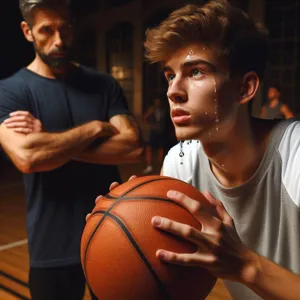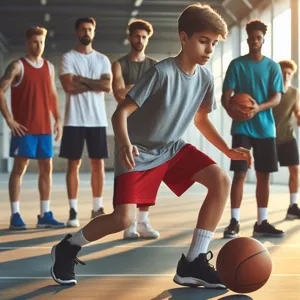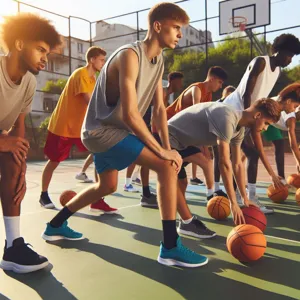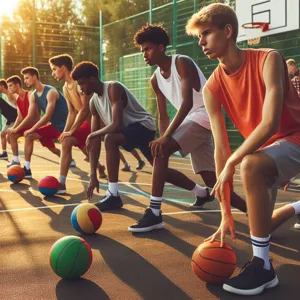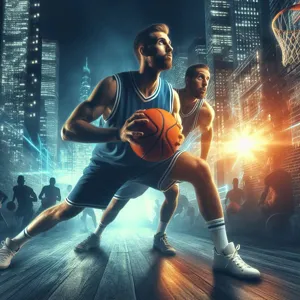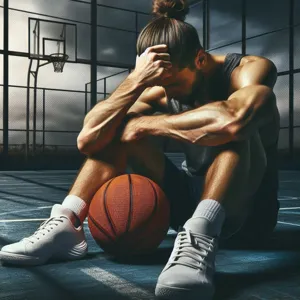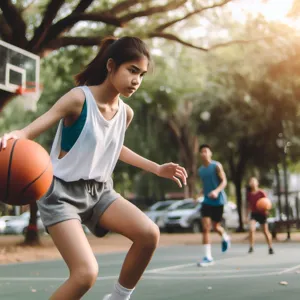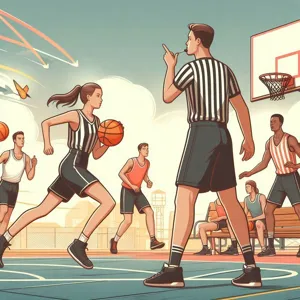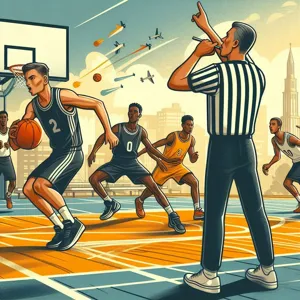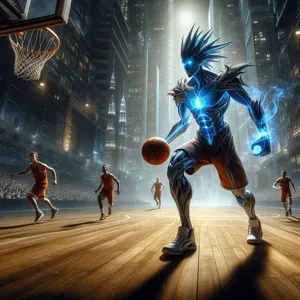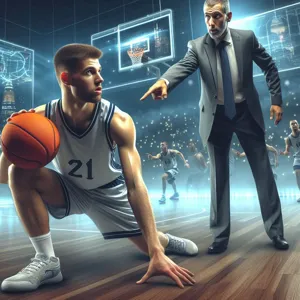Basketball is more than just a game; it’s a vibrant tapestry woven with stories of triumph, perseverance, and evolution.
From its humble beginnings on a gymnasium court in Springfield, Massachusetts, to the dazzling arenas filled with roaring fans today, the history of basketball is rich and dynamic. For enthusiasts eager to delve into the chronicles of their favorite sport, discovering its roots, legendary players, and unforgettable moments can be both enlightening and inspiring. In this blog post, we’ll explore a curated selection of top resources that will take you on a journey through basketball history. Whether you’re a seasoned fan or a newcomer to the game, these books, documentaries, websites, and podcasts will offer a comprehensive look at the milestones, the rivalries, and the cultural impact of basketball across generations. Lace up your sneakers as we score big with knowledge and appreciation for this beloved sport!
1. Introduction to Basketball History

Basketball, a sport that has captured the hearts of millions around the globe, has a rich and vibrant history that traces its roots back to the winter of 1891. Invented by Dr. James Naismith, a physical education instructor in Springfield, Massachusetts, the game was originally devised as a way to keep his students active indoors during inclement weather. Naismith hung a peach basket at each end of the gymnasium, and the objective was simple: throw a soccer ball into the opposing team’s basket. Little did he know that this humble beginning would evolve into a cultural phenomenon that would shape the fabric of sports and society.
From its early days, basketball has continually transformed, evolving rules, styles, and strategies that reflect broader societal changes. The introduction of dribbling, the establishment of the National Basketball Association (NBA) in 1946, and the global expansion of the game through international competitions have all played pivotal roles in the sport’s development. Each era has produced legendary players who have left indelible marks on the game—figures like Michael Jordan, Kareem Abdul-Jabbar, and LeBron James, whose impact transcends the court.
As we delve into the annals of basketball history, we uncover not just the statistics and accolades but also the stories of resilience, innovation, and the spirit of competition that define this beloved sport. Whether you’re a lifelong fan or a newcomer eager to learn, understanding basketball’s past helps enrich your appreciation for the game today. In this blog post, we will explore the top resources available to deepen your knowledge of basketball history, from books and documentaries to online archives and museums dedicated to celebrating this dynamic sport. Join us as we journey through time, uncovering the milestones that have made basketball the thrilling game we know and love.
2. The Origins of Basketball: A Brief Overview
The story of basketball begins in December 1891, in the chilly confines of the International YMCA Training School in Springfield, Massachusetts. It was here that Dr. James Naismith, a physical education instructor, sought to create a new indoor game to engage his students during the cold winter months. With a simple objective to keep the students active, Naismith devised a set of 13 basic rules and hung a peach basket at each end of the gymnasium, marking the birth of a sport that would evolve into a global phenomenon.
The game was initially played with a soccer ball, and the goal was to throw the ball into the opposing team’s basket—a concept that seems straightforward today, but was revolutionary at the time. The first official game of basketball recorded a final score of just 1-0, a testament to the sport’s nascent and experimental nature. As more players began to join in and refine the rules, basketball quickly gained popularity, spreading from local YMCAs to colleges and professional leagues.
Over the years, basketball has undergone significant transformations, including the introduction of dribbling and the three-point line, which have shaped the fast-paced and dynamic game we know today. The sport has also seen the rise of legendary figures—players like Michael Jordan, LeBron James, and Kareem Abdul-Jabbar—who have not only pushed the boundaries of athletic performance but also elevated basketball into a cultural phenomenon, influencing fashion, music, and social movements.
To truly appreciate the game we love, it’s vital to explore its rich history, from Naismith’s humble beginnings to the thrilling matches we witness today. By delving into this extensive timeline, enthusiasts can gain insights into how basketball became a beloved sport worldwide, uniting fans across generations and cultures.
3. Key Historical Milestones in Basketball

Basketball, a sport rich in history and culture, has seen numerous pivotal moments that have shaped its evolution and popularity across the globe. Understanding these key historical milestones is essential for any basketball enthusiast looking to appreciate the game on a deeper level.
One of the most significant events occurred in 1891 when Dr. James Naismith, a physical education instructor, invented the game in Springfield, Massachusetts. Tasked with keeping his students active indoors during the winter months, Naismith devised a set of rules and hung a peach basket at each end of the gym, forever changing the landscape of sports.
Fast forward to 1936, when basketball made its Olympic debut at the Berlin Games. This not only elevated the sport’s status internationally but also showcased the incredible talent of players like the legendary Jesse Owens, who inspired countless athletes, including basketball stars.
The establishment of the National Basketball Association (NBA) in 1946 marked another significant turning point. The league quickly grew, attracting top talent and creating a platform for the sport to flourish. Legends like Bill Russell and Wilt Chamberlain emerged during the 1960s, setting records and elevating the game to new heights, while the Boston Celtics and Los Angeles Lakers rivalry captivated fans.
The global expansion of basketball in the late 20th century saw the formation of the Dream Team in 1992, which included iconic players such as Michael Jordan, Magic Johnson, and Larry Bird. This team not only dominated the Barcelona Olympics but also helped popularize basketball around the world, inspiring a new generation of players and fans.
In recent years, the integration of advanced analytics and technology has transformed how the game is played and understood. From player tracking systems to data-driven strategies, these innovations continue to propel basketball into the future, ensuring that its rich history remains intertwined with ongoing progress.
By exploring these historical milestones, fans can gain a deeper appreciation for the sport and understand how basketball has evolved from its humble beginnings to become a global phenomenon. Whether you’re a seasoned player or a casual fan, knowing the key moments in basketball history will enhance your experience and connection to the game.
4. Essential Books on Basketball History
When it comes to delving into the rich tapestry of basketball history, there’s no better place to start than with a collection of essential books that have shaped the understanding of the game. These meticulously researched works not only chronicle the evolution of basketball but also highlight the key figures, pivotal moments, and cultural shifts that have defined this beloved sport.
One standout title is “The Breaks of the Game” by David Halberstam. This gripping narrative takes readers into the 1979-1980 season of the Portland Trail Blazers, offering an intimate look at the players and the intricate dynamics of the team. Halberstam’s storytelling prowess captures the highs and lows of the season, providing a microcosm of the larger basketball landscape.
Another must-read is “Basketball: A History of the Game” by the renowned historian and writer, Bob Pomerantz. This comprehensive book spans the early days of basketball, tracing its origins in gymnasiums to its emergence as a global phenomenon. Pomerantz’s engaging prose and thorough research make it an invaluable resource for anyone looking to understand the game’s development over the decades.
For fans interested in the influence of superstar athletes, “The Jordan Rules” by Sam Smith offers a revealing look into Michael Jordan’s legendary career with the Chicago Bulls during their first championship season. Smith’s behind-the-scenes access provides deep insights into the complexities of team dynamics and the pressure of high-stakes competition.
Lastly, “Basketball: The History of the Game” by the National Basketball Association is a beautifully illustrated book that serves as both a visual feast and an informative guide. It chronicles key milestones, iconic players, and memorable moments through stunning photographs and engaging narratives, making it a perfect addition to any basketball enthusiast’s library.
Exploring these essential books on basketball history will not only enhance your understanding of the game but also deepen your appreciation for the players and stories that have shaped it over the years. Whether you’re a seasoned fan or new to the sport, these titles promise to ignite your passion for basketball’s rich heritage.
5. Documentaries and Films That Captivate Basketball’s Legacy

When it comes to exploring basketball history, few mediums are as powerful and engaging as documentaries and films. These visual narratives dive deep into the sport’s rich legacy, bringing to life the stories, struggles, and triumphs of iconic players, legendary teams, and pivotal moments that have shaped the game we love today.
One standout documentary that every basketball enthusiast should watch is “The Last Dance.” This critically acclaimed series chronicles Michael Jordan’s monumental career with the Chicago Bulls during the 1990s, offering an inside look at the relentless drive and determination that defined a generation of players. Through exclusive interviews and never-before-seen footage, viewers gain a profound appreciation for Jordan’s impact on the sport and the cultural phenomenon that basketball became.
Another gem worth exploring is “Hoop Dreams,” a seminal documentary that follows the lives of two talented high school basketball players in Chicago. This film not only highlights their athletic aspirations but also delves into the socioeconomic challenges they face, serving as a poignant reminder of the intersection between sports and society. As you watch their journey unfold, you’ll be captivated by the raw emotion and authenticity that resonates throughout the film.
For fans of scripted storytelling, films like “He Got Game” and “Space Jam” offer a unique blend of basketball culture and cinematic flair. “He Got Game,” directed by Spike Lee, tells the compelling story of a father trying to reconnect with his son, a basketball prodigy, amidst a backdrop of personal and societal struggles. Meanwhile, “Space Jam,” with its blend of animation and live-action, brings together the beloved Looney Tunes characters and NBA superstar Michael Jordan in a whimsical showdown that has become a nostalgic favorite for many.
Whether you’re revisiting classic moments or discovering the untold stories of the sport, documentaries and films serve as a captivating gateway into basketball’s legacy. They not only entertain but educate, allowing fans to appreciate the game’s history and its profound influence on culture and society. So, grab some popcorn, settle into your favorite spot on the couch, and get ready to be inspired by the stories that continue to shape the world of basketball.
6. Notable Basketball Museums and Exhibits
When it comes to delving into the rich tapestry of basketball history, few experiences can compare to exploring notable basketball museums and exhibits. These curated spaces are more than just collections of memorabilia; they are vibrant narratives that celebrate the sport, its legends, and its evolution over the decades.
One of the most iconic destinations for basketball enthusiasts is the Naismith Memorial Basketball Hall of Fame in Springfield, Massachusetts. This museum, named after the inventor of the game, James Naismith, houses over 400 inductees, showcasing their stories through interactive displays, engaging multimedia presentations, and an impressive array of artifacts. From Michael Jordan’s championship jerseys to the original peach baskets, the Hall of Fame allows visitors to walk in the footsteps of legends and experience the milestones that have defined the sport.
Another gem is the College Basketball Experience, also located in Kansas City, Missouri. This immersive attraction allows visitors to explore the rich heritage of college basketball through hands-on exhibits, including shooting games, skills challenges, and a replica court that pays tribute to the NCAA Tournament. It’s not just a museum; it’s an invitation to step onto the court and experience the thrill of the game firsthand.
For those interested in a more localized experience, many cities and regions host smaller basketball exhibits, often highlighting local legends or historic teams. These spaces often feature community-driven artifacts, storytelling elements, and interactive displays that connect fans to their local basketball history. Whether it’s a high school gym turned museum or a pop-up exhibit at a local sports festival, these venues provide valuable insights into how basketball has shaped communities across the nation.
As you embark on your journey through basketball history, make it a point to visit these notable museums and exhibits. They not only celebrate the sport but also inspire a deeper appreciation for the players, coaches, and fans who have contributed to basketball’s enduring legacy. Whether you’re a die-hard fan or a casual observer, walking through these hallowed halls will undoubtedly deepen your connection to the game.
7. Online Archives and Digital Resources for Basketball History

In the digital age, the wealth of information available at our fingertips has transformed the way we explore and understand basketball history. Online archives and digital resources offer an unprecedented opportunity to delve into the rich tapestry of the sport, from its humble beginnings to the modern-day phenomena.
One of the most valuable resources is the **Naismith Memorial Basketball Hall of Fame**’s extensive online archive, which showcases a treasure trove of inductee profiles, historical artifacts, and multimedia content that captures the essence of basketball legends. Here, you can browse through induction speeches, photographs, and memorabilia that tell the stories of the game’s greatest contributors.
Additionally, websites like **Basketball Reference** provide in-depth statistics and historical data spanning decades. With detailed player stats, game logs, and team performance metrics, these platforms allow fans and researchers alike to analyze trends, compare players, and understand the evolution of strategies over time.
For those interested in a more narrative-driven approach, **documentary films and series** available on streaming platforms bring historical moments to life. Titles like “The Last Dance,” which chronicles Michael Jordan’s era with the Chicago Bulls, not only entertain but also educate viewers about pivotal moments in basketball history.
Moreover, many universities and institutions have digitized their basketball archives, making rare photographs, articles, and game footage accessible to the public. The **Library of Congress** and various sports history museums have taken steps to preserve and share these artifacts, enriching our understanding of the game’s impact on culture and society.
Whether you are a die-hard fan wishing to relive the glory days, a student of the game eager to learn about its roots, or a casual viewer looking to appreciate basketball’s evolution, these online archives and digital resources provide an invaluable gateway to the past. Embrace the opportunity to explore the history of basketball like never before, and you may just discover stories and insights that will deepen your appreciation of this beloved sport.
8. Influential Players Who Shaped the Game
Basketball, as we know it today, is a vibrant tapestry woven from the contributions of countless players. Among them, a few stand out not only for their skill on the court but also for their profound influence on the game’s evolution. Understanding the legacies of these influential players is essential for anyone looking to delve deeper into basketball history.
Take, for instance, Michael Jordan – a name synonymous with basketball excellence. His dynamic playing style, competitive spirit, and iconic moments, such as his clutch performances in the NBA Finals, not only defined an era but also transformed the NBA into a global phenomenon. Jordan’s impact extended beyond the hardwood; he became a cultural icon, bridging the gap between sports and entertainment, and inspiring generations of players and fans alike.
Then there’s Bill Russell, whose defensive prowess and leadership redefined what it meant to be a winner in basketball. With an astounding 11 NBA championships to his name, Russell’s emphasis on teamwork and resilience laid the foundation for modern basketball strategies. His activism off the court also made him a significant figure in the civil rights movement, merging sports and social justice in powerful ways.
Another transformative player is Magic Johnson, whose extraordinary vision and passing ability revolutionized the point guard position. With his infectious charisma and style of play, he helped popularize the fast-paced, high-scoring game that fans have come to love. Magic’s rivalry with Larry Bird not only elevated both players but also brought the NBA into the spotlight during the 1980s, ushering in a new era of basketball fandom.
Kobe Bryant, often referred to as one of the most skilled scorers in history, left an indelible mark with his work ethic and relentless pursuit of excellence. His “Mamba Mentality” inspired countless players to strive for greatness and pushed the boundaries of what was thought possible on the court.
As you explore basketball history, consider the stories, statistics, and cultural impacts of these players. Their journeys reflect the game’s evolution, showcasing how individual talent and dedication can shape not only a sport but also the very fabric of society. By understanding the influence of these legends, you gain a richer perspective on the game and its ongoing legacy in the world of sports.
9. The Evolution of Rules and Gameplay Over the Decades
The evolution of rules and gameplay in basketball over the decades is a fascinating journey that reflects not only the sport’s growth but also the changing dynamics of society and culture at large. From its humble beginnings in 1891, when Dr. James Naismith hung a peach basket at the YMCA in Springfield, Massachusetts, and devised a set of 13 basic rules, basketball has undergone significant transformations that have shaped how the game is played today.
In the early years, the game was characterized by a slower pace, limited scoring, and a lack of specialized positions. Players primarily passed the ball to each other, with little emphasis on individual skill. However, as the sport gained popularity, so too did the necessity for more structured gameplay. The introduction of the dribble in the early 1900s was a game-changer, allowing players greater freedom to move and create scoring opportunities. This shift led to a faster-paced game that became increasingly exciting for fans.
Fast forward to the 1950s and 60s, and the game began to see the emergence of the three-point line, drastically altering offensive strategies. This rule change allowed for greater versatility in shooting and expanded the court’s dimensions, making it a more dynamic sport. As players became more athletic and skilled, the game evolved further with the introduction of shot clocks, which heightened the urgency of scoring and encouraged more aggressive play.
In more recent decades, the rules have continued to adapt to the changing landscape of basketball. The implementation of the defensive three-second rule in the NBA, as well as changes regarding hand-checking and physical play, has emphasized the need for finesse and skill over brute strength. These adaptations have not only made the game more entertaining for viewers but have also paved the way for a new generation of players who excel in speed, agility, and shooting prowess.
Exploring the evolution of basketball rules and gameplay provides a deeper understanding of the sport’s rich history. It showcases how the game has transformed from a simple pastime into a global phenomenon, capturing the hearts of millions around the world. For basketball enthusiasts, delving into these changes is not just an academic exercise; it is a celebration of the sport’s resilience and its ability to adapt and thrive through the ages. Whether you are a player, a coach, or an avid fan, appreciating the historical context of basketball can enhance your love for the game and inspire a greater appreciation for the athletes who bring it to life.
10. Major Basketball Events and Their Historical Significance
Basketball, much like the players who grace its courts, has a rich and dynamic history, marked by pivotal events that have shaped the game we know and love today. Understanding these major basketball events not only enhances your appreciation for the sport but also provides insight into the cultural and social changes that have influenced basketball over the years.
One of the most significant events in basketball history is the introduction of the NCAA tournament in 1939, which transformed college basketball into a national sensation. This event has become an annual spectacle, captivating millions of fans and elevating the profiles of countless players, many of whom have gone on to have illustrious professional careers. The tournament’s “March Madness” phenomenon highlights the unpredictability and excitement of the game, making it a staple in American sports culture.
Similarly, the establishment of the NBA in 1946 marked a turning point for professional basketball. The league has since evolved into a global powerhouse, with its championship games drawing international audiences and its players becoming global icons. Events like the NBA Finals and the All-Star Game not only showcase incredible talent but also symbolize the league’s ability to unite fans from diverse backgrounds.
Another cornerstone event is the 1992 Barcelona Olympics, where the “Dream Team” represented the United States. This iconic team, featuring legends like Michael Jordan, Magic Johnson, and Larry Bird, not only dominated the competition but also served as a catalyst for the globalization of basketball. Their remarkable performance and sportsmanship inspired a new generation of players worldwide and significantly raised the profile of basketball as a global sport.
Additionally, the introduction of the WNBA in 1996 has played a crucial role in elevating women’s basketball, providing a professional platform for female athletes and inspiring young girls to pursue the sport. The league has celebrated remarkable moments, such as championship series and individual player achievements, which continue to reshape perceptions of women in sports.
By exploring these major basketball events and their historical significance, you gain a deeper understanding of the game’s evolution, the athletes who have left an indelible mark on its legacy, and the cultural shifts that have propelled basketball into the hearts of fans across the globe. Whether you’re a seasoned fan or a newcomer to the sport, recognizing these milestones will enrich your experience and appreciation for the rich tapestry of basketball history.
11. Iconic Rivalries That Defined Eras in Basketball
Basketball has always been more than just a game; it’s a tapestry woven with stories of fierce competition and legendary rivalries that have defined eras and captivated fans around the world. These rivalries are not only marked by the intensity of the games but also by the personalities, stakes, and drama that unfolded on and off the court.
Take, for instance, the legendary showdown between the Boston Celtics and the Los Angeles Lakers. Spanning decades, this rivalry has featured some of the greatest players in the history of the sport—Bill Russell, Larry Bird, Magic Johnson, and Kobe Bryant—all of whom left an indelible mark on the game. Their meetings in the NBA Finals became epic battles, each game a crucial chapter in a saga that transcended mere sports and became a cultural phenomenon.
Another iconic rivalry that defined a generation is that of the Chicago Bulls and the Detroit Pistons, famously known as the “Bad Boys.” The fierce physicality of the Pistons’ play style clashed with the elegance of Michael Jordan and the Bulls, showcasing the evolution of basketball in the late 1980s and early 1990s. This rivalry not only highlighted the struggle for supremacy in the Eastern Conference but also served as a crucible for Jordan, shaping him into the player who would eventually revolutionize the league.
More recently, the battles between the Golden State Warriors and the Cleveland Cavaliers have captivated audiences, particularly during their four consecutive Finals matchups from 2015 to 2018. The emergence of superstars like Stephen Curry and LeBron James has brought new energy and excitement to the sport, turning each encounter into a must-watch spectacle.
Exploring these iconic rivalries gives fans a deeper understanding of the game’s history and evolution. It’s a chance to witness how these fierce competitions have influenced player dynamics, team strategies, and the overall culture of basketball. As you dive into the histories of these rivalries, you’ll not only appreciate the sport more deeply but also gain insight into the broader narratives that make basketball a truly dynamic and enduring spectacle.
12. The Impact of Basketball on Culture and Society
Basketball is more than just a game; it is a vibrant tapestry woven into the very fabric of culture and society. Since its invention in 1891, the sport has evolved into a global phenomenon, influencing everything from fashion and music to politics and social movements. The court serves as a battleground not just for athletic competition, but for cultural expression and social change.
Historically, basketball has played a pivotal role in breaking down racial barriers. The integration of the NBA in the 1950s, marked by the talents of players like Bill Russell and Wilt Chamberlain, propelled the sport into the forefront of the civil rights movement. These athletes transcended their roles as players, becoming symbols of hope and resilience for marginalized communities. Their stories serve as a reminder of basketball’s power to unite, inspire, and instigate change.
Moreover, the cultural impact of basketball extends beyond the hardwood. The sport has birthed a unique style, influencing fashion trends with oversized jerseys, snapback hats, and signature sneakers that have become staples in streetwear. Hip-hop music has also embraced basketball, with countless artists referencing the sport in their lyrics, collaborating with players, and even creating songs that pay homage to the game. This symbiotic relationship has given rise to a distinct culture that celebrates not only athletic prowess but also creativity and self-expression.
Basketball also fosters community. Local courts serve as gathering places where diverse groups come together, bridging gaps and building friendships. The sport promotes values such as teamwork, discipline, and perseverance, which resonate far beyond the court. Whether it’s youth leagues or professional teams, the sense of belonging and camaraderie that basketball instills is a testament to its significant role in shaping social dynamics.
In exploring the profound impact of basketball on culture and society, one can see how the sport has evolved into a powerful medium for storytelling, activism, and cultural exchange. It is a dynamic force that continues to influence generations, reminding us that the love for the game is not just about points on a scoreboard, but about the connections we forge and the changes we inspire.
13. Resources for Learning About Women’s Basketball History
As the dynamic sport of basketball continues to evolve, the rich history of women’s basketball often remains overshadowed by its male counterpart. However, a wealth of resources exists that illuminate the incredible achievements, struggles, and triumphs of women in the game. Exploring these resources not only deepens your understanding of the sport but also celebrates the remarkable female athletes who have shaped its landscape.
One of the finest starting points is the **Women’s Basketball Hall of Fame**, which honors players, coaches, referees, and contributors who have made significant impacts on the game. Their website offers a treasure trove of biographies, statistics, and historical timelines that chronicle the evolution of women’s basketball from its inception in the late 19th century to the present day.
For those seeking a more academic perspective, delve into the book **“Breaking the Code of Good Intentions: Women’s Basketball in America”** by Joan H. B. Jones. This comprehensive text examines the societal impacts and cultural shifts that have influenced women’s basketball over the decades, providing a critical lens through which to understand the sport’s growth and the barriers it has faced.
Additionally, the **Women’s Sports Foundation** provides insightful research and reports on female athletic participation, including basketball. Their studies highlight not only the historical context but also the current trends and challenges women athletes encounter, making it an invaluable resource for anyone interested in women’s sports.
Podcasts, such as **“The Dream Team”**, offer a modern and engaging way to learn about women’s basketball history. These audio narratives dive into the stories of trailblazing athletes and pivotal moments in women’s sports, making history accessible and relatable.
Lastly, don’t overlook the plethora of documentaries available on streaming platforms. Films like **“A League of Their Own”** or **“The 40-Year-Old Version”** provide entertainment while reflecting on the realities faced by women athletes, blending history with culture in an engaging format.
By exploring these resources, you’ll not only gain a deeper appreciation for the game itself but also empower yourself with knowledge about the women who have tirelessly fought for their place on the court. Their stories are an integral part of basketball history and continue to inspire future generations of players.
14. Engaging with Basketball History Through Podcasts
In the digital age, podcasts have emerged as an engaging and accessible way to delve into the rich tapestry of basketball history. Whether you’re a die-hard fan or a casual observer, there’s a treasure trove of audio content waiting to be explored. These dynamic, conversational formats bring the stories of basketball legends, iconic games, and pivotal moments to life, making the past feel vibrantly present.
Imagine tuning in to a podcast that recounts the legendary rivalry between Larry Bird and Magic Johnson, with expert insights and firsthand accounts that transport you back to the electrifying 1980s. Or perhaps you’re intrigued by the untold stories of underdog teams that defied the odds and left an indelible mark on the sport—podcasts often feature interviews with players, coaches, and historians, giving you a front-row seat to these narratives in a way that books or articles simply cannot replicate.
Moreover, many basketball podcasts offer a blend of storytelling and analysis, dissecting the evolution of the game, rule changes, and key figures who have shaped basketball into what it is today. With episodes ranging from in-depth explorations of specific seasons to discussions about the cultural impact of the NBA, you can customize your listening experience based on your interests.
Podcasts also foster a sense of community among listeners. Engaging with fellow fans through social media platforms or podcast comment sections can lead to lively discussions, recommendations, and deeper insights into basketball history. So, whether you’re on your morning commute, hitting the gym, or lounging at home, tuning into a basketball history podcast is an excellent way to connect with the sport you love and gain a deeper appreciation for its legacy. Start exploring today and let the stories of basketball’s past enrich your understanding of the game!
15. Conclusion: Why Understanding Basketball History Matters
As we draw this exploration of basketball history to a close, it’s essential to reflect on why understanding the past of this beloved sport matters so profoundly. The history of basketball is not merely a timeline of games won and lost; it’s a rich tapestry woven with the stories of perseverance, innovation, and cultural impact. Each era of the game has contributed to the evolution of basketball as we know it today, shaping not only the athletes who play but also the fans who cheer and the communities that thrive around the sport.
Delving into basketball history allows us to appreciate the groundbreaking achievements of legendary players, from the pioneering efforts of early stars like James Naismith, the sport’s inventor, to the transformative influence of icons like Michael Jordan and LeBron James. Their stories are not just about their on-court accomplishments; they are narratives of personal struggles, social change, and the relentless pursuit of excellence.
Moreover, understanding basketball history fosters a deeper connection between fans and the game. It enriches the experience of watching a match, as knowledge of past rivalries, historic moments, and the evolution of playing styles adds layers of meaning to each dribble and shot. It also highlights the sport’s role in broader societal movements, showcasing how basketball has been a platform for addressing issues such as race, equality, and community engagement.
In conclusion, as we celebrate the rich history of basketball, let us remember that it is more than just a game. It is a reflection of our society, a source of inspiration, and a catalyst for change. By understanding and appreciating this history, we not only honor those who paved the way but also enrich our own experiences as fans, players, and members of a vibrant basketball community. So, whether you’re a lifelong enthusiast or a newcomer to the sport, take the time to explore the resources available, and let the history of basketball inform and inspire your journey within this dynamic arena.
As we wrap up our exploration of the top resources for diving into basketball history, we hope you feel inspired to deepen your appreciation for this dynamic sport. From iconic documentaries and captivating biographies to comprehensive databases and interactive exhibits, the world of basketball history is rich with stories and insights waiting to be uncovered. Whether you’re a seasoned fan or a newcomer eager to learn more, these resources will not only enhance your knowledge but also ignite your passion for the game. So lace up your sneakers, grab your favorite basketball book, and embark on a journey through the incredible legacy of basketball. Remember, every shot you take in understanding the past helps you score big in your appreciation of the present and future of this beloved sport!





